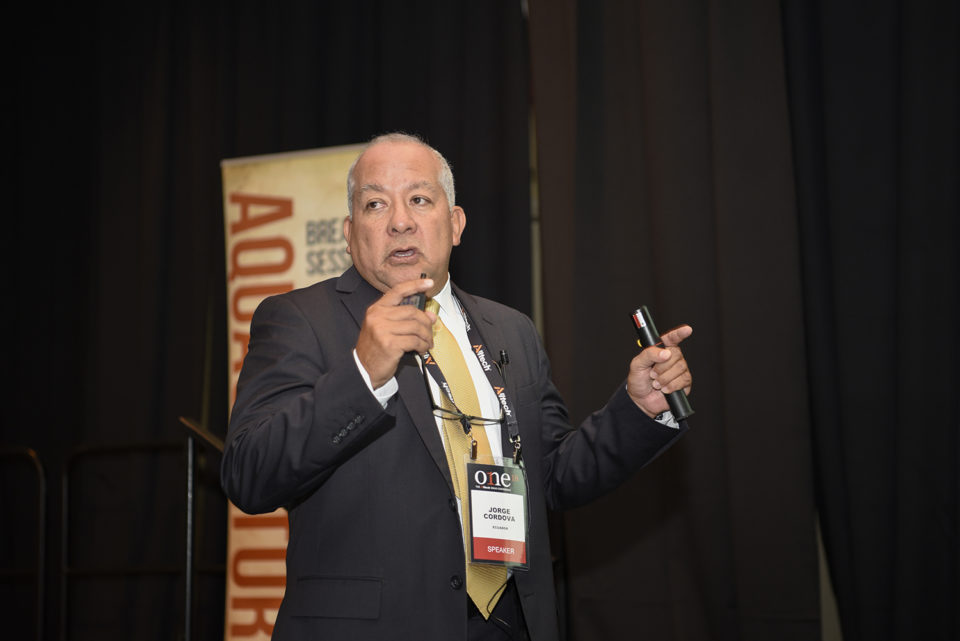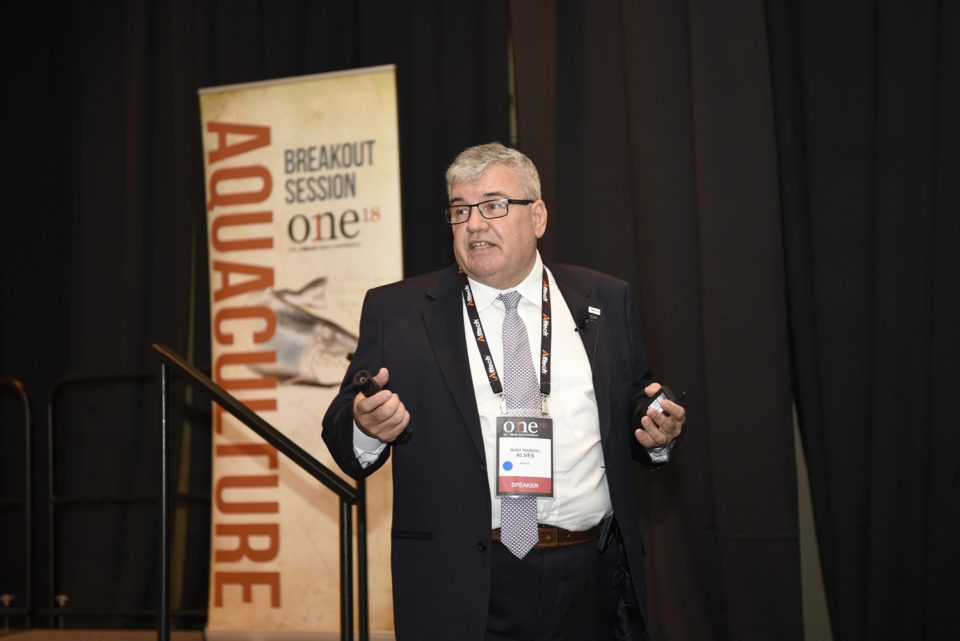Kentucky conference program includes aquafeed nutrition, sea lice prevention and RAS

The consensus among several presenters at the aquaculture portion of the Alltech ONE18 conference was clear: Much more seafood is needed to feed humans, whose numbers will reach 8 billion in less than six years.
Discussions of how producers will meet that need were more wide-ranging. Whether through modernizing and organizing low-tech operations in the Amazon River basin or improving fish disease management through genetic manipulation, any and all changes were viewed as necessary to meet the challenge. Improving human health through consuming aquaculture products requires those fishes and crustaceans themselves be healthy. Equally important, presenters stressed, was all methods applied to fish farming must not harm an already stressed planet.
The potential of the Amazon River
According to João Manoel Cordeiro Alves, aquafeed product manager at Alltech, the 6,600-kilometer stretch of Amazon River basin is ripe for aquaculture development. Yet significant investment in new farms, processing operations, feed improvement and fish health are required to trigger those changes.
“We need modern production systems and electricity for equipment like aerators,” Alves said, adding that most post-harvest production facilities are small and outdated. Having livestock that can thrive in high-density situations, he added, are a must. “We can’t produce a half kilo per hectare per year. It’s not profitable or sustainable.”
Home to 350 people groups who consume a per-capita average of 50 kilos of seafood a year, the Amazon basin has a ready customer base. But until better systems are in place for delivering product domestically and, eventually, globally, the region will struggle to catch up with more advanced farmers.
The region must also “domesticate just a few species and focus on them,” Alves said. Just as Norway did with salmon, focusing on a few species will help farmers move Amazon fishes “all over the world.”
Listening to shrimp to learn how they eat
Historically shrimp farming has been a guessing game of “putting them in the pond and not seeing them until harvest time,” said Jorge Cordova, production manager at Naturisa, in Ecuador. But with hydrophone technology developed by Australian farmers, shrimp producers can now hear their livestock eat, and the benefits have been multifold.
“It told us they weren’t eating early in the day, when we fed them,” Cordova said. Learning the shrimp routinely fed between 2 and 8 p.m. helped them better target the amount of feed served as well. “We are learning to feed the animals when they want, not when we think they want.”
Cordova then discussed newly discovered benefits of synbiotic feed that includes probiotics and prebiotics. According to early tests, mortality among shrimp consuming the feed declined due to improved disease immunity. The product’s dissolution in water also promotes phytoplankton and zooplankton growth, boosts soil quality and controls ammonia. The overall reward was a noticeable improvement in feed conversion ratios.
“In 2017, Ecuador produced more than 400,000 metric tons of shrimp,” he said. “I believe we can double production in the years to come.”

Salmon farming growing offshore, onshore
While the costs of salmon farming have doubled since 2008, Oyvind Fylling-Jensen, CEO of Nofima AS in Norway, said the salmon farming industry is buoyed by record profits and a willingness to innovate and automate systems. Across the globe there are at least 20 land-based farms using recirculating aquaculture systems (RAS) technology, and once-cutting-edge offshore salmon farms are being upstaged by units nine times as large. High-tech farms now in operation are using dazzling computerized automation.
One example Fylling-Jensen showed in a video was called iFarm, an offshore salmon farm whose computers utilize image processing to identify each individual fish in order to measure their weight, growth and welfare. Computers can determine whether there are injuries, deformities, discoloration or sea lice. As fish travel through the iFarm, operators can alert the system to sort fish for individualized custom treatment.
“The salmon industry is under technology disruption,” Fylling-Jensen said. “New technology is needed to address customer needs and animal welfare. You can’t beat biology with technology or money. You have to understand all factors.”
Trout farming transformed by RAS
Water recirculation has always challenged fish farmers, but according to Gijs Rutjes, technical sales support manager at Alltech Coppens, continued advances in RAS filtration and feed development has made freshening water supplies much easier.
Recent advancements began in Denmark, where government pressure to reduce farm water pollution led researchers to develop better methods for water oxygenation and carbon dioxide stripping. Improvement in fixed- and moving-bed filter systems also were created. A somewhat unexpected bonus: Farmers have greatly increased stocking density.
Feed also needed changing, Rutjes said, and higher energy density products were developed.
“Feed that’s high in digestibility gives you lower amounts of excrements,” Rutjes said. “It also yields high protein retention and low total ammonia nitrogen (TAN) production.”
Advanced RAS systems, he added, offer “unparalleled opportunity … to control oxygen, ammonium, [carbon dioxide] levels and temperature. When you can maintain optimal conditions, profitability and sustainability are greatly increased.”
No fish makes great fish feed
Most aquaculture feed includes marine ingredients, which ostensibly places limits on production growth. According to Alltech Coppens nutritionist Ruben Groot, that led Alltech to create Neo Green, a high-performance feed that’s free of fishmeal and fish oil. To get vital nutrients commonly found in marine ingredients, Neo Green uses terrestrial animal byproducts, as well as algae, a key source of omega-3 fatty acids. Using standard fish feeds, Groot said farmers need at least 700 grams of food to produce 1 kilogram of fish.
“But Neo Green (uses) zero fish,” Groot said.
To the surprise of some, he said plant protein sources were less than desirable because of their high fiber content.
“That causes a higher volume of feces, which causes problems in recirculation systems,” he said. Fish eating Neo Green passed fiber-free feces “that is more easily removed by filtration.”
Feeding genetic potential
Fifteen years ago, Alltech Chief Scientific Officer Dr. Karl Dawson stayed busy gathering data on feed conversion and growth. Now, with the ability to analyze animal DNA, “we have a whole set of new tools we to evaluate what’s going on at a whole different level … things we’ve never seen before in terms of food and nutrition and what’s going on in fish.”
Using implanted microchips, Dawson can examine 30,000 to 40,000 genes to learn about immune functions, tissue development and repair, complex neurological responses, hormonal responses and functional food interactions. Armed with such data, he can provide insight into nutrition management at the producer level.
The technology is also furthering study into damage caused by sea lice. Dawson’s teams have seen negative changes in a salmon’s gene expression within hours of a sea lice infestation. Through genetic manipulation, researchers are developing techniques to make fish resistant to damage via increased production of mucin, a skin lubricant produced by fish that helps prevent lice from attaching to them.
“We’re not saying we’ve got a product that will completely eliminate sea lice, but we do have indications that our one dose we’ve tested … can mitigate what’s going on with sea lice,” Dawson said. The result, he added, are “new ways of challenging the traditional nutritional concepts and really revolutionize what’s going on as a result of these activities.”
Follow the Advocate on Twitter @GAA_Advocate
Author
-

Steve Coomes
Steve Coomes is a veteran journalist who has written for and edited dozens of national trade and consumer publications centered on food, drink and travel. He has authored and ghostwritten several books and speaks regularly to enthusiast and trade groups on food and spirits. He lives in Louisville, Ky. You can find more of his work at www.stevecoomes.com.
Tagged With
Related Posts

Innovation & Investment
Eight digital technologies disrupting aquaculture
Eight digital technologies are disrupting aquaculture and having a profound impact on the way business operates – even displacing some established ones.

Innovation & Investment
GOAL 2017 video: Langley Gace, InnovaSea Systems
In the fifth Pecha Kucha presentation from the Global Aquaculture Alliance’s annual GOAL conference in Dublin, Ireland, Langley Gace of InnovaSea Systems talks about open-ocean aquaculture and how the future of fish farming is happening now.

Innovation & Investment
Thinking outside the cage: Avant-garde aquaculture in Norway
Salmon farming in Norway is poised for an innovation boom. The biggest players are putting cutting technology in the water to solve some of the industry’s most persistent problems, such as sea lice, fish escape and waste management.

Health & Welfare
Animal health giants have sea lice in their crosshairs
Alltech and Benchmark have been working on the next generation of sea lice solutions and believe they have new products that can help salmon farmers win.

